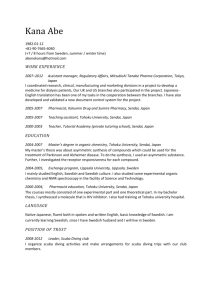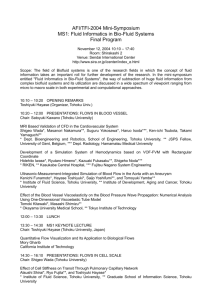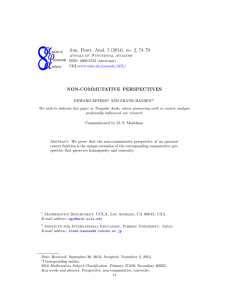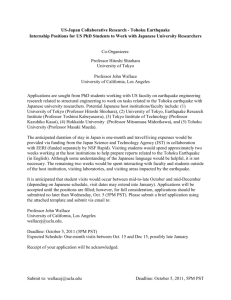REGIONAL SPILLOVER EFFECTS OF THE TOHOKU EARTHQUAKE (MARCH 2016) Robert Dekle, Eunpyo Hong,
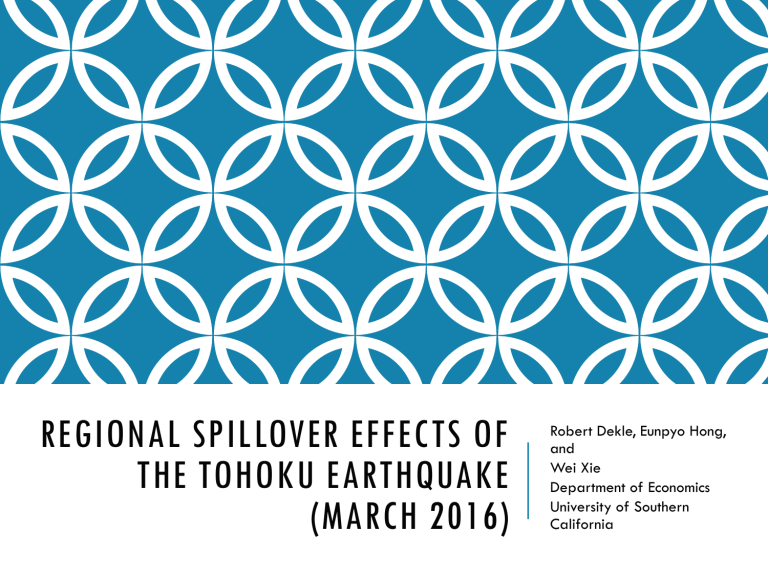
REGIONAL SPILLOVER EFFECTS OF
THE TOHOKU EARTHQUAKE
(MARCH 2016)
Robert Dekle, Eunpyo Hong, and
Wei Xie
Department of Economics
University of Southern
California
Work to understand how the 2011 earthquake shock was transmitted throughout Japan.
Focus is on how the relationship among regions can propagate the exogenous earthquake shock.
Focus on Industrial Production. Available monthly. Correlates with GDP.
2
TWO MAIN STRANDS OF REGIONAL
INTERACTIONS
1. STRUCTURAL CALIBRATED MULTISECTORAL
MODELS (DUPOR, 1999; CALIENDO, ET. AL.
2015).
2. TIME SERIES METHODS WITH BROAD
STRUCTURAL RESTRICTIONS (REICHLIN AND
FORNI, 2000; SHEA, 1998).
THIS PAPER IS IN SECOND STRAND.
3
REGIONAL INTERACTIONS ARE COMPLEX
NOT JUST INPUT-OUTPUT
TECHNOLOGICAL SPILLOVERS
DEMAND EFFECTS. TOHOKU IP FALLS, CHUBU
SALES TO TOHOKU FALLS, CHUBU IP FALLS.
4
FINDINGS
The maximal impact of the earthquake occurs in about 6 months.
The Tohoku shock was about 33 percent of Tohoku Industrial
Production on impact.
Analysis Shows:
I N 1 MONTH , THE IMPACT ON AGGREGATE J APANESE INDUSTRIAL PRODUCTION
WAS 6 PERCENT ; IN 6 MONTHS , 12 PERCENT ; AND IN 20 MONTHS , 9.6
PERCENT .
5
JAPANESE INDUSTRIAL PRODUCTION
6
Shock to aggregate IP was much larger during the financial crisis of
2009 than the effect of the earthquake.
The effect of the earthquake was highly concentrated in Tohoku, which experienced a decline in industrial production that was larger than during the financial crisis.
7
MAIN REGIONS OF JAPAN
8
REGIONS DICTATED BY AVAILABILITY OF
REGIONAL INPUT-OUTPUT TABLES
REGIONAL MONTHLY INDUSTRIAL
PRODUCTION DATA FROM REGIONAL METI
OFFICES.
9
LARGE DECLINES IN TOHOKU AND KANTO
IP
10
SOUTHERN REGIONS EXPERIENCED LITTLE
EFFECT
11
IMPACT OF EARTHQUAKE ON REGIONAL
AND AGGREGATE IP OVER TIME
Confounding factors on regional IP. After the earthquake, massive fiscal and rescue (both govt and charitable) spending in Tohoku and nearby regions, raising demand and IP. Appreciation of the yen caused by tight U.S. monetary policy also hurt Japanese IP. Cut in spending all over Japan due to empathy with the plight of people of people in
Tohoku also lowered regional IP. (Cancellation of cherry blossom viewing festivals.)
Need to try to isolate Tohoku Earthquake impact by estimating model on long time series sample and examining impulse responses of Tohoku shock on each region, and then aggregating these regional responses.
Earthquake is about 3 standard deviation shock to Tohoku IP.
12
METHODOLOGY: HOLLY, PESARAN AND
YAMAGATA (2011)
Model of spatial and temporal diffusion
Two crucial preliminary steps.
1.
Define a “ dominant ” region:
Its output growth has contemporaneous effects on the other regions.
The other regions have no contemporaneous effects on its output growth.
13
CONTINUED
2.
For each region, define its “ neighbor ” :
Weighted average of the other regions’ output growth.
Weights are computed by some measure of proximity to the region
(not necessarily geographical).
14
SPECIFICATION
Dominant region’s Y = Error correction term with its “neighbors”
+ Own lags + Lagged effects from its “neighbors”
Non-dominant region’s Y = Error correction term with its “neighbors”
+ Error correction term with the dominant region
+ Own lags + Lagged effects from its “neighbors”
+ Contemporaneous effects from the dominant region
15
SIMILARLY,
Spatio-Temporal VAR structure (Pesaran 2006).
16
region. Statistically, need to define the dominant region because it becomes the
(Pesaran, 2006).
Five measures of proximity, interrelatedness, economic distance.
“Similarity” in industrial structure (correlated technology shocks). (Conley and Dupor, 2003)
“Selling”, Input-Output, Tohoku Supply Effects (Acemoglu, et. al. 2012)
“Buying”, Tohoku Demand Effects
“Mutual buying”.
Contiguity, Two Regions share Common Border. but finite samples plausible.
17
ECONOMIC DISTANCE MATRICES: S(I,J)
S(i,j), how region i is interrelated to the other matrices.
18
THREE MAIN S(I,J) MATRICES
“Similarity” matrix. Conley and Dupor (2003) holds that two regions are technologically if they buy goods from similar industries. Smaller the closer. A measure of technology spillovers.
19
20
MUTUAL BUYING MATRIX
21
THE “BUYING” MATRIX IS JUST THE FIRST
TERM OF THE “MUTUAL BUYING” MATRIX;
AND THE “SELLING” MATRIX IS THE SECOND
TERM.
22
23
CONTIGUITY MATRIX
Contiguity Matrix. Two Regions Share a Border. How two regions are related to each other.
24
25
ESTIMATION RESULTS
Estimation sample: Monthly IP data by Region, January 1998-October
2012
A positive “own lag” implies that the series continues to drift in the same direction as last period. A negative “own lag” implies that the series adjusts to last period’s increase by a decrease in the current period. Significant own lag effects for most regions are found.
26
A positive “neighbor lag” effect implies that the series moves in the same direction as the weighted average of the industrial production of its neighbors in the last period. The estimated “neighbor lag” effects are mostly positive.
The magnitude of “Neighbor lag” tends to be highest for the “buying” and “mutual buying” economic distance measures.
“Kanto current” effect is the estimated contemporaneous effects of
Kanto--all positive.
27
28
SPATIO-TEMPORAL IMPULSE RESPONSE
FUNCTIONS
We trace out how a decline in industrial production in one region can be propagated throughout Japan.
After the model is estimated, we shock Tohoku IP by 1 standard deviation.
We take Tohoku, and see how a shock to industrial production in
Tohoku owing to the earthquake can be propagated throughout
Japan.
29
IMPULSE RESPONSE FUNCTIONS
Impulse responses are very similar for all five measures of economic distance.
For all measures, the response of Chubu seems to be the largest. The response of Shikoku is the smallest.
30
31
PERSISTENCE PROFILE OF TOHOKU SUGGESTS
THAT IT TAKES ABOUT 2 YEARS FOR TOHOKU
TO ABSORB A UNIT SHOCK TO ITS MONTHLY
IP LEVEL, ALTHOUGH IP LEVEL REMAINS
LOWER THAN BEFORE.
THE PERSISTENCE PROFILES OF OTHER
REGIONS OTHER THAN TOHOKU SHOW THAT
A POSITIVE SHOCK CAN BE ADJUSTED
WITHIN A YEAR’S TIME, ALTHOUGH IP LEVEL
REMAINS LOWER THAN BEFORE.
32
33
34
GIRF ACROSS REGIONS AND OVER TIME.
THE REGIONS ARE ORDERED FROM LEFT TO
RIGHT ACCORDING TO THEIR “CLOSENESS”
TO TOHOKU (ACCORDING TO THE THREE
MEASURES OF ECONOMIC DISTANCE). IF
“CLOSENESS” RESULTS IN HIGHER
SPILLOVERS, THEN WE SHOULD SEE A
DECLINING PATTERN IN THE GRAPHS. AS THE
REGIONS BECOME FURTHER FROM TOHOKU,
EFFECTS OF THE TOHOKU SHOCK SHOULD
DISSIPATE.
35
OUR CLOSENESS MEASURES DON’T CAPTURE
PROPAGATION OF SHOCKS PERFECTLY FOR
REGIONAL IP.
FOR ALL TIME PERIODS, CHUBU RESPONDS
THE MOST TO A TOHOKU SHOCK, FOLLOWED
BY KINKI.
36
37
THERE WERE MANY OTHER SHOCKS HITTING
JAPAN FOLLOWING 2011 SHOCK.
DECLINE IN CONSUMPTION ACCORDING TO
NEGATIVE CONSUMER SENTIMENT. FORCED
CONSERVATION OF ELECTRICAL POWER
USAGE THROUGHOUT JAPAN.
IMPULSE RESPONSES FROM THE SHOCK TO
TOHOKU SHOULD BE ORTHOGONAL TO THESE
OTHER FACTORS.
38
TO FOCUS MORE ON THE ROLE OF TOHOKU IN
SUPPLYING INTERMEDIATE PARTS, WE LOOK
AT TWO IMPORTANT PARTS INDUSTRIES IN
TOHOKU: ELECTRICAL MACHINERY AND
TRANSPORT EQUIPMENT.
SHOCKS TO THE ELECTRICAL MACHINERY
INDUSTRY HAD LARGE AND IMPORTANT
EFFECTS ON THE ELECTRICAL MACHINERY
INDUSTRY ALL OVER JAPAN, EXCEPT FOR THE
HUGE REGIONS OF KANTO AND KINKI.
39
40
41
SAME RESULTS FOR THE TRANSPORTATION
INDUSTRY, LARGE EFFECTS ON CHUBU REGION
42
RESULTS FOR THE TRANSPO
43
44
QUANTIFICATION
RETURNING TO THE AGGREGATE IP.
WHAT IS THE IMPACT OF EARTHQUAKE
SHOCK TO TOHOKU ON AGGREGATE GDP?
45
TOHOKU SHOCK WAS ABOUT 3 SD SHOCK TO
TOHOKU IP.
CAN READ OFF MULTIPLIERS TO REGIONAL IP
FOR EACH TIME HORIZON, EG, KANTO IN 6
MONTHS.
CAN WEIGH THE REGIONAL IP RESPONSES BY
REGIONAL SHARE OF AGGREGATE IP. EG.
KANTO IP 0.40 PERCENT OF AGGREGATE IP
46
1 M0NTH, 6 PERCENT NEGATIVE SHOCK TO
AGGREGATE IP.
6 MONTHS, 12 PERCENT NEGATIVE SHOCK TO
AGGREGATE IP.
20 MONTHS, 9.6 PERCENT NEGATIVE SHOCK
TO AGGREGATE IP.
ACTUAL IP DECLINE SMALLER BECAUSE OF
FISCAL POLICY, ETC.
47
CONCLUSIONS
Look at other plausible “interaction” or economic distance measures.
Tohoku shock Response similar across measures.
Maximal response less than one year.
Chubu aggregate IP responds the most to Tohoku shock.
Draw implications for Macro. and Trade.
48


